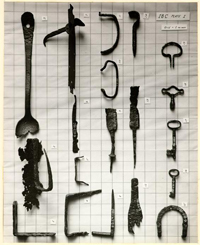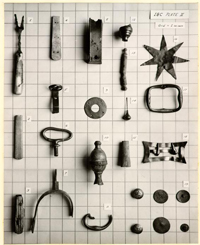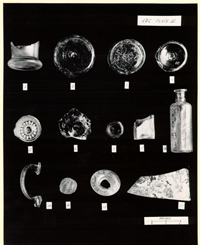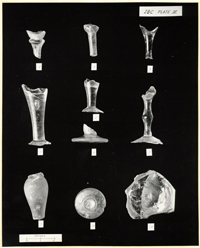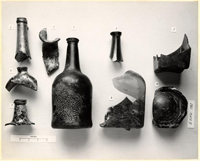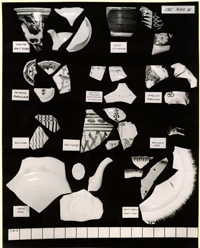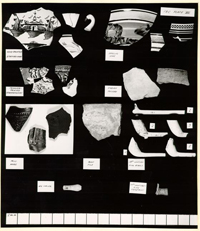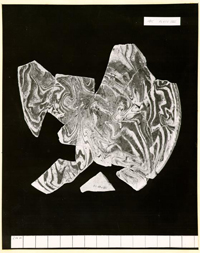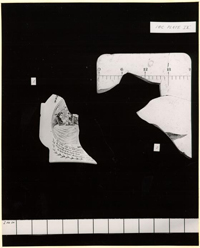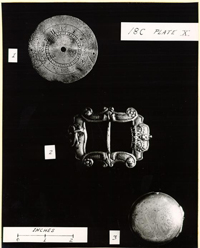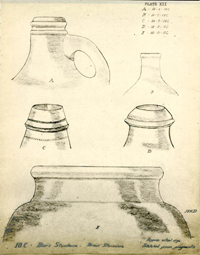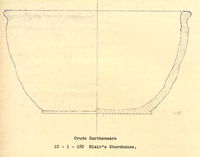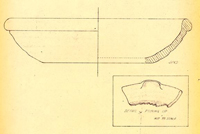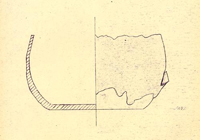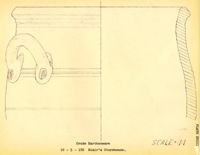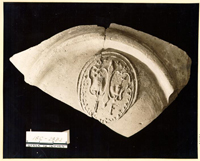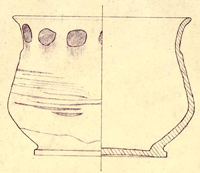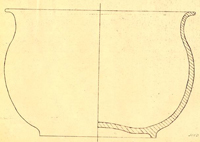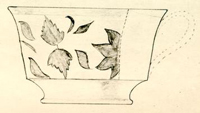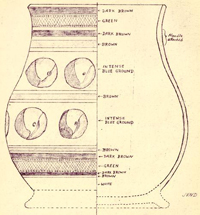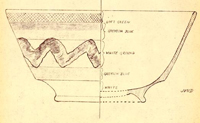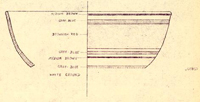Archibald Blair Storehouse (NB) Archaeological Report,
Block 18 Building 6A Lot 46Originally entitled: "The Archibald Blair Storehouse Site
Block 18 Colonial Lot No. 46
Archaeological Area 18c Williamsburg, Virginia"
Colonial Williamsburg Foundation Library Research Report Series - 1405
Colonial Williamsburg Foundation Library
Williamsburg, Virginia
1990
To: Mr. Orin M. Bullock, Jr.
From: Mr. Moreau B. C. Chambers
I take pleasure in transmitting a report prepared in the Archaeological Laboratory upon the artifacts from the Archibald Blair Storehouse site (18C), responsive to a request originated by the Curator.
Illustrations are the work of Mr. Thomas L. Williams, Photographer, and of Mr. John V. N. Dunton, Archaeological Treatment Assistant in the Laboratory.
Moreau B. C. Chambers
MBCC:AAHTo: Mr. John M. Graham, Jr.
From: M. E. Campioli
I am handing you herewith the Archaeological Laboratory Report on the material excavated on the site of Archibald Blair Storehouse, Archaeological Area 18C.
This is in response to your request of March 1, 1954.
A report on the findings at Mrs. Campbell's Coffee Shop is now in preparation.
So little material was recovered from the site of the Ayscough House, no report is possible.
M. E. C.
Enclosure
Copy to:
Archaeological Laboratory
Copy with enclosure to:
Mrs. Goodwin, Research Office
Mrs. Sewell, Archives
CMB:HWG
THE ARCHIBALD BLAIR STOREHOUSE SITE
BLOCK 18Colonial Lot No. 46, Archaeological Area 18C
Williamsburg, Virginia
ARCHAEOLOGICAL LABORATORY REPORT
OFFICE OF ARCHITECTURAL RESEARCH
Colonial Williamsburg
June 24, 1954
INTRODUCTION
The following represents the first effort by the staff of the Archaeological Laboratory to produce a formal descriptive report upon the artifacts found during excavation of an archaeological area of Colonial Williamsburg.
Its general arrangement is in harmony with the system adopted in mid-1953 for presentation of a statistical evaluation of the artifacts found on individual sites, and based upon earlier studies conducted in the Laboratory.
Included in this presentation is the tabular, statistical evaluation, indicative of quantities found, followed by a qualitative evaluation of the metal, glass, stone, and ceramics present, with certain generalizations developed under each heading, or by categories. In cases where it is considered helpful, an attempt has been made to give an itemized description of entire holdings, as, for instance, the metal found on this site. With respect to glass, however, only the more significant items from this collection are described. The ceramic portion of this collection has particular interest, and in nearly each category discussed, a few general remarks are included which refer to the period of use of specific types of ceramics present in this collection and in most cases illustrated by sketches or photographs.
It is well to bear in mind, while using Laboratory reports, that the collections of Eighteenth or Nineteenth Century artifacts found by excavation of any particular site cannot with absolute assurance be identified as having seen use on the site where encountered, although in some instances archaeological field data furnish strong support for such conclusions.
Particular appreciation is expressed for the assistance, artistic and otherwise, which was furnished by Mr. John V. N. Dunton, Archaeological Treatment Assistant in the Laboratory, during the preparation of this report. Mr. Dunton's informed enthusiasm for ceramics has united with his artistic talents in producing the sketches, reconstructions, and scale drawings utilized in this study. Appreciation also is expressed for use of the research notes on ceramics in America, lent generously by Mr. Minor Wine Thomas, Jr., and in this report employed in rendering more interesting the background notes on ceramics found at Williamsburg.
M. B. C. C.
SITE 18C (ARCHIBALD BLAIR'S STOREHOUSE)
TABLE OF CONTENTS
| Title Page | |
| Memorandum of Transmittal | 1 |
| Introduction | |
| Table of Contents | 2 |
| Key to Statistical Artifact Report (Facing) | 4 |
| Statistical Artifact Report | 4 |
| Comments on Metal from Site | 5 |
| Inventory of Iron Material from Site | 6 |
| Plate I (Iron) | |
| Inventory of Brass, Copper, and Bronze Material from Site | 8 |
| Plate II (Brass, Copper, Bronze) | |
| Inventory of Miscellaneous Metals from Site | 10 |
| Comments on Glass from Site | 11 |
| Plates III, IV, V | |
| Comments on Stone from Site | 12 |
| Comments on Ceramics | 13 |
| Plates VI, VII, VIII, IX, X | |
| Class 1A, Brown Stoneware | 14 |
| Plates XI, XII | |
| Class 2A, White Salt Glaze Stoneware | 15 |
| Plate XIII | |
| Class 3A, Gray Stoneware | 16 |
| Class 1B, Chinese Porcelain | 16 |
| Class 2B, Chinese Porcelain (polychrome enameled) | 16 |
| Class MB, Miscellaneous English Porcelain | 16 |
| Class 1C, Crude Earthenware | 17 |
| 3 | |
| Plates XIV, XV, XVI, XVII, XVIII, XIX | |
| Class 2C, Slipware | 21 |
| Plates XX, XXI | |
| Class 3C, Delftware | 23 |
| Plate XXII | |
| Class 4C, Whieldon Ware (Tortoiseshell, Pineapple, Cauliflower) | 24 |
| Class 5C, Creamware | 24 |
| Class 6C, Blue- and Green-Edged Ware | 24 |
| Class 7C, Hand-painted Staffordshire Ware | 25 |
| Plate XXIII | |
| Class 8C, Annular Ware | 25 |
| Plates XXIV, XXV, XXVI | |
| Class 9C, Transfer-printed Staffordshire Ware | 27 |
| Class 10C, Indian Pottery | 28 |
| Class MC, Miscellaneous Pottery | 28 |
| Class 1T, Tile | 29 |
Legend for Archaeological Report - Artifacts
CERAMICS
- 1ABrown Stoneware
- 2AWhite Salt Glaze
- 3AGray Stoneware
- MAMiscellaneous Stoneware
- 1BChinese Porcelain
- 2BChinese Porcelain (Polychrome Enameled)
- MBMiscellaneous English Porcelain
- 1CCrude Earthenware
- 2CSlip-decorated Ware
- 3CDelftware
- 4CWhieldon (Tortoise Shell, Pineapple, Cauliflower, Agate)
- 5CCream Ware
- 6CBlue and Green Edged Ware
- 7CHand-painted Staffordshire
- 8CAnnular Ware
- 9CTransfer-printed Staffordshire
- 10CIndian Pottery
- MCMiscellaneous Pottery
- 1TTile
IRON
- 1.Military Goods
- 2.Tools and Implements
- 3.Harness and Horse Furniture
- 4.Household Hardware
- 5.Cabinet Hardware
- 6.Builder's Hardware
- 7.Nails, Spikes
- 8.Hinges
- 9.Locks and Keys
- 10.Miscellaneous
BRASS
- 1.Buckles
- 2.Ornaments
- 3.Spurs, Harness
- 4.Bronze Winecocks
- 5.Buttons
- 6.Fire Irons
- 7.Cabinet Hardware
- 8.Watches, Clocks
- 9.Military
- 10.Candlesticks and Snuffers
- 11.Household Utensils
- 12.Hardware
- 13.Miscellaneous
CWI 6/1954
4
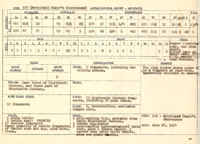 SITE 18C (Archibald Blair's Storehouse) ARCHAEOLOGICAL REPORT - ARTIFACTS
SITE 18C (Archibald Blair's Storehouse) ARCHAEOLOGICAL REPORT - ARTIFACTS
Comments on Metal from Site 18C
(Archibald Blair's Storehouse)
The metal found on this site is in no respect unusual or distinctive in comparison with similar material recovered from other sites of Colonial Williamsburg. Both Eighteenth and Nineteenth Century types of metal have been found at this site.
The iron objects described below by standard categories are those remaining after the greater bulk of iron material obviously pertaining to the Nineteenth Century had been sorted out and placed in non-current storage. It is possible, however, that some Nineteenth Century material may still be included with the remaining study collections of iron types which were in use during the Eighteenth Century.
The study collections of brass and other metals, relatively small in comparison with the total volume of iron found on this site, similarly may include some Nineteenth Century objects with the types characteristic of the Eighteenth Century.
Inventory of Iron Material from Site 18C
(Archibald Blair's Storehouse)
- Class 1, Military Goods:
1 sword fragment, showing tang and 4" of blade (catalogue number 1-147-18C; illustrated in Plate I, Number 13). - Class 2, Tools and Implements:
1 wood gouge, fragmentary (catalogue number 2-374-18C; illustrated in Plate I, Number 9); 2 shoemaker's pliers (catalogue numbers 2-97-18C and 2-98-18C); 1 sledgehammer; 1 4" gimlet (catalogue number 2-123-18C). - Class 3, Harness and Horse Furniture:
1 wagon fixture (threaded keeper for retaining tail-gate rod; catalogue number 6-240-18C). - Class 4, Household Hardware:
2 fragments of iron cooking pots (one of which is a 3-legged, flat-bottomed vessel, 9" in basal diameter, catalogued as 4-205-18C, while the other bears catalogue number 4-220-18C); 1 razor blade, 5 3/8" long (catalogue number 4-107-18C; illustrated in Plate I, Number 6); 1 2-tined bone-handled table fork, with overall length of 6½" (illustrated in Plate II, Number 1; note that Numbers 2, 3 and 4 in Plate II show other handles of bone); 2 kitchen spoons, long-handled (catalogue numbers 4-88-18C, illustrated in Plate I, No. 3, and 4-114-18C); 1 hook, attached to flat metal surface (catalogue number 4-204-18C, illustrated in Plate I, Number 2). - Class 5, Cabinet Hardware:
3 drawer-pulls (the first and second, bearing catalogue numbers 5-6-18C and 5-13-18C, are illustrated in Plate I, Numbers 10 and 11, respectively, while the third, not illustrated, bears catalogue number 5-15-18C). - Class 6, Builder's Hardware:
1 hook, 4" long, with threaded tip (catalogue number 6-74-18C, illustrated as Plate I, Number 14); 1 hook (catalogue number 6-98-18C); 1 chainhook (catalogue number 6-95-18C); 1 clamp for securing stone slabs, 9/16" wide x 2¼" long (catalogue number 6-68-18C, illustrated in Plate I, Number 5). - 7
- Class 7, Nails and Spikes:
5 spikes, ranging in length from 3" to 7 7/8" (catalogue numbers 7-6-18C, 7-55-18C, 7-93-18C, 7-104-18C, 7-144-18C); 3 staples (catalogue numbers 9-11-18C, 9-229-18C, 9-288-18C). - Class 8, Hinges:
1 HL type (catalogue number 8-10-18c); 1 strap type, 22" long (catalogue number 8-197-18C); 2 fragmentary hinges (catalogue numbers 8-38-18C and 8-78-18C); 2 pintles (1 of these bears catalogue number 8-257-18C and is illustrated in Plate I, Number 8; the other, not shown, bears catalogue number 8-264-18C). - Class 9, Locks and Keys:
1 rim-lock face-plate (catalogue number 9-472-18C); 1 lock-bolt (catalogue number 9-378-18C); 1 hook (catalogue number 9-343-18C); 1 hasp (catalogue number 9-320-18C, illustrated in Plate I, Number 1); 1 door-latch (catalogue number 9-537-18C, illustrated in Plate I, Number 7); 4 iron keys (catalogue numbers 9-166-18C; 9-199-18C, illustrated in Plate I, Number 17; 9-202-18C; 9-209-18C); 1 key, 2 5/8" long, of which length, 15/16" is brass, only the handle being iron (catalogue number 9-197-18C, illustrated in Plate I, Number 16); 1 wine-cock key, 2 1/8" long, on the handle of which remain traces of plating (catalogue number 2-163-18C, illustrated in Plate I, Number 18); 2 large staples, or bar-keepers, for doors (catalogue numbers 9-236-18C, illustrated in Plate I, Number 4, and 9-330-18C). - Class 10, Miscellaneous:
Frame of jews-harp, measuring 1 7/8" across the frame (catalogue number 10-8-18C, illustrated in Plate I, Number 19); T-shaped object (catalogue number 6-190-18C); broken object, shoe-horn-like in shape, approximately 5" long, of thin iron and bearing rows of perforations, possibly an epaulette frame (?) (catalogue number 6-99-18C, illustrated in Plate I, Number 12); small horseshoe-like object, of iron 3/8" wide and forming an arch 2 7/8" high, perforated by three nail-holes (catalogue number 6-80-18C, illustrated in Plate I, Number 15).
Inventory of Brass, Copper, and Bronze Material from Site 18c
(Archibald Blair's Storehouse)
- Class 1, Buckles:
1 brass harness buckle (catalogue number 1-37-18C, illustrated in Plate II, Number 17); wide sheet-brass buckle (catalogue number 1-64-18C, illustrated in Plate II, Number 18); 1 brass harness buckle, 3 1/8" x 2¼", ornamented above by crown and below by running horse, and at corners by roses and thistles (catalogue number 1-2-18C, illustrated in Plate X, Number 2). - Class 2, Ornaments:
Finial, 3½" long (illustrated in Plate II, Number 10). - Class 3, Spurs, Harness, and Allied Equipment:
Spur, fragmentary; terret (catalogue number 3-32-18C); unidentified brace (catalogue number 7-26-18C). The three objects of Class 3 are illustrated in Plate I, Numbers 7, 6, and 3, respectively. - Class 4, Bronze Wine-Cocks:
1, fragmentary (illustrated in Plate II, Number 15). - Class 5, Buttons:
2 Virginia military buttons, each bearing variant forms of the present Great Seal of Virginia; 1 mutilated copper coin, possibly used as a cloth-covered button; 6 other buttons. An array of six of these buttons are illustrated in Plate II, Number 19. - Class 6, Fire Irons:
Brass knob for squared poker-head (?) (catalogue number 6-12-18C, illustrated in Plate II, Number 12). - Class 8, Watches, Clocks:
Brass clock face, 2½" in diameter (catalogue number 8-1-18C; illustrated in Plate X, Number 1). - Class 12, Hardware:
Brass hinge-post (?), 3/8" in diameter, 3½" long, and perforated by a 3/16" hole through the post, from side to side (illustrated in Plate II, Number 13); 9 brass door-lock keeper (catalogue number 12-49-18C; illustrated in Plate II, Number 8); door handle escutcheon, 1 13/16" in diameter (catalogue number 12-43-18C, illustrated in Plate II, Number 9); door handle, drop type, fragmentary (catalogue number 7-33-18C, illustrated in Plate II, Number 11). - Class 13, Miscellaneous:
Brass knob, ½" in diameter, attached on its tapered end to an inch-long bit of heavy brass wire (illustrated in Plate II, Number 14); 7-pointed star, 4 7/8" across, cut from sheet copper, having small perforations ½" from tip of one point, and bearing on one surface, scratched across the center of the star, three connecting links of chain, as in the emblem of the I.O.O.F. (illustrated in Plate II, Number 16).
Inventory of Miscellaneous Metals from Site 18C
(Archibald Blair's Storehouse)
- One silver watch-case back, 2" in diameter, and ornamented with an intricate rusticated cypher of the letters "AG", is among the collections from this site on display in the Archaeological Museum. Hall-marks stamped into its inner surface attest that this metal contains 92.5% silver and 7.5% copper, as certified by the London Assay Office, and that it was made between May 1761 and May 1762. Illustrated in Plate X, Number 3.
- A smooth conical ferrule (or finial) of lead (or soft white metal) about 2½" in length. There is a small fillet at the larger end (¾" diameter) which is hollow and tapered, threaded (on the inside) with coarse threads for about 1". The other end (top?) is solid and formerly terminated in a carved or moulded feature now gone. There is a necking (½" diameter) approximately 2" from the larger end separating the decorated work. It is thought to be later than 18th century and may have been a decorative finial or terminal feature for such objects as clocks, fireplace fittings, and the like.
Comments on Glass from Site 18C
(Archibald Blair's Storehouse)
This site yielded on the whole slightly more than an average amount of glass, datable as from the Late Eighteenth and Early Nineteenth Centuries. The earlier material is evidently hand-blown, although on certain bottles there is evidence of the use of a mold during the shaping process.
Bottles of dark green glass show a range in diameters from eight inches to one inch. The usual wine bottle found here had a diameter of from three to three and one-half inches, a size also fairly standard for the square bottles from this site. Illustrations appear in Plate V. A complete bottle recovered from this site has a diameter of four and one-fourth inches and stands nine inches high; its shape is illustrative of the later rather than of the earlier period; it is pictured in Plate V, Number 3. One octagonal bottle base, measuring four and one-half inches across, and similar in shape and size to the recognizable John Greenhow bottles which bear the seals dated 1769 and 1770, is in this collection; however, the upper portion, which usually bears the distinctive seal, is missing from this example. Note the illustration in Plate V, Number 9.
One bottle seal (not illustrated), possibly somewhat distorted from being at sometime in a fire, bears "Prentis" as its faint legend, noteworthy from the connection of this site with the Prentis mercantile firms.
Some bottles of a later period, made on the whole from a pale green glass, are in this collection. It is possible that they may have served as containers for patent-medicine, extracts, or perfume. Illustrations are furnished in Plate III, Numbers 7, 8 and 9.
Approximately a dozen fragmentary water tumblers of clear glass were found, together with a few bottle rims and a few glass stoppers used in perfume or toilet-water bottles. Examples of the foregoing are shown in Plate III, Numbers 1-6, and 12, together with a pitcher handle (Number 10) and an ornamental, twisted knob (Number 11), and a fragment of glass pane, 4mm. thick, noticeably iridescent (Number 13). Also in this collection is an irregularly broken slab of clear glass, approximately five-eighths inch thick, showing considerable wear on one edge and its slightly concave base, and which might have served as the base for a lamp or other furnishing that required a pedestal. It is shown in Plate IV, Number 10.
Eighteen wine glass fragments, some with quite heavy stems, were found at this site. Representative examples appear in Plate IV, Numbers 1-9.
Comments on Stone from Site 18C
(Archibald Blair's Storehouse)
The collections from this site contain the five stone fragments listed below:
- A six-inch curved segment of the milled edge of a sandstone slab 2 1/8" thick, smoothed and scored on only one face, possibly for use as a mill-stone; catalogued as 3-118-18C.
- A fragment of black veined stone, polished smooth on one flat face, with oyster-shell mortar adhering to the roughly worked opposite face; possibly a piece of hearthstone. Approximate dimensions, 4½" x 3½" x 1¼"; catalogued as 3-51-18C.
- A fragment of sandstone, smoothed flat on only one surface, approximately 7" x 5", and about 5" thick; catalogued as 3-170-18C.
- A worked, broken fragment of dense, gritty gray stone, flat on one face, apparently the end of a slab 4" wide and 1¼" thick, possibly used in grinding or polishing work. Catalogued as 3-18-18C.
- A cobble-stone (?), worn smooth on its irregular faces, gray-green in color, and weighing approximately 8 pounds. Catalogued as 3-171-18C.
Comments on Ceramics from Site 18C
(Archibald Blair's Storehouse)
A study has been made of the ceramic material from this site in its relationship to material in the study collections from other excavated sites of Colonial Williamsburg. This material varies in no appreciable extent from the quantity or range of types or patterns encountered on the average habitation site in Colonial Williamsburg.
This presentation follows a systematic classification of ceramics that through the years has been found applicable, both at Williamsburg and elsewhere within the English trade orbit, for a study of ceramic development in the Seventeenth, Eighteenth, and Early Nineteenth Centuries.
A brief description is furnished of the general types of ceramic material under each category that is represented by sherds found at this site, and specific examples have been selected to illustrate, wherever possible, each category.
Description of Ceramics from Site 18C
(Archibald Blair's Storehouse)
- Class 1A, Brown Stoneware:
This material consists of sherds of heavy flat-bottomed jugs and jars, none sufficiently well represented to permit a physical restoration of any single vessel, but still adequate to justify reconstruction of shapes, approximate dimensions, and designs or decorations. Many shades of brown are represented. Most handles are of the loop pattern shown in the accompanying sketches (Plates XI and XII); one wide-mouthed jar is equipped with lug handles. Common to Seventeenth and Eighteenth Centuries. - Plate XI - Brown Stoneware Jug
Thickness is approximately 8 millimeters, with a basal thickness of approximately 12mm. Ware is extremely hard and glazed.
The shape and design selected to represent this type, and hypothecated in this sketch from study of uncatalogued sherds, are for a vessel approximately 18" high. The bases of vessels of this category are uniformly flat.
- Plate XII - Design Elements Present in Brown Stoneware
Approximately full-sized typical necks of jugs, bottles, and jars of this heavy ware are sketched, showing decorative treatment. Notation on the sketch identifies the sherds by catalogue number.
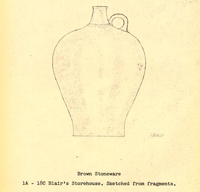 PLATE XI
PLATE XI
Brown Stoneware
1A - 18C Blair's Storehouse. Sketched from fragments.
- Class 2A, White Salt-Glaze Stoneware
White salt-glazed table ware was developed in England early in the Eighteenth Century and was in vogue in Williamsburg by mid-century. A few sherds found upon this site permitted reconstruction of the scale drawing of the small bowl figured in Plate XIII; it is decorated only at the rim and has a basal rim upon which the bowl stands. Other sherds represent a mug with loop handle, decorated below the rim with a band of rocker-applied ornamentation. The collection also contains fragments of a cobalt-decorated chamber-pot, ornamented with a molded "GR" surmounted by a crown, this medallion having been applied to the vessel before its glazing. (Note the selection of sherds figured in Plate VI). - Plate XIII - White Salt-Glaze Bowl
Thickness of ware is approximately 4.5mm. at base and thins out to 2.5mm. just below a slightly flaring rim.
Diameter at rim, 6 7/8"; height, 2 11/16".
This vessel has as decoration a small ridge 3/16" below the rim on its exterior. Reconstructed from sherd catalogued as 2A-107-18C.
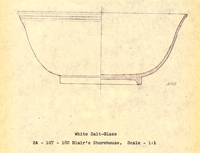 PLATE XIII
PLATE XIII
White Salt-Glaze
2A - 107 - 18C Blair's Storehouse. Scale - 1:1
- Class 3A, Gray Stoneware
Gray stoneware, characteristically German in style, workmanship, and probably in origin, was a rough household and commercial ware of the Eighteenth Century, which was still being manufactured in America as late as 1850. Included in this collection are sherds of cobalt- and manganese-decorated jugs, mugs, and chamber-pots, of which some bear rampant lions embossed as moldings in low relief on the surfaces of these vessels, incised rosette patterns, and other floral ornamentation. (Note illustrations in Plate VI). - Class 1B, Chinese Porcelain
Chinese porcelain, decorated both inside and out with a characteristic shade of blue and in a profusion of patterns, both realistic and conventional, was popular in Williamsburg in the Eighteenth and Nineteenth Centuries. It was advertised for sale in Williamsburg as early as 1718. Fragments of this ware appear on most sites. Several sherds of a very heavy, possibly rectangular-shaped bowl bearing blue decorations both inside and outside the rim, with a naturalistic exterior band of blossoms and leaves of roses and other flowers, were found on this site. Other sherds also found here are of blue-decorated mugs, cups, and platters. (Note illustrations in Plate VI). - Class 2B, Chinese Porcelain (polychrome enameled)
The collections from this site contain bowls, saucers, and cups representative of this well-recognized type of thin porcelain, frequently but, incorrectly known as "Lowestoft", which is characterized by delicate ornamentation, usually of colors other than the "Chinese willow-ware" blue, and which are applied as an overglaze enamel. Porcelain of this type was probably present in Williamsburg as early as 1760. (Illustrative sherds from this site appear in Plate VI). - Class MB, Miscellaneous English Porcelain
In an effort to meet the competition of imported porcelains, chiefly from China, English potters toward the middle of the Eighteenth Century experimentally developed soft-paste porcelains. Very popular in England, some of this ware was being advertised in the 17 Virginia Gazette for sale in Williamsburg as early as 1766. Almost invariably, Chinese shapes and decorations were used. Only three sherds of this rare type have been identified as coming from this site: one is a fragment of a cup bearing a simple floral pattern; another is a rim-sherd of a small bowl with dragon design appearing on both inner and outer surfaces; the third is a fragment of the base of a bowl having a high basal rim. (These sherds appear in Plate VI). - Class 1C, Crude Earthenware
A great bulk of crude earthenware, manufactured almost entirely in England, was imported into Virginia during the Seventeenth and Eighteenth Centuries. Although a feeble beginning had been made at Yorktown as early as 1732, the industry vanished in Virginia with the death of the potter two years later and apparently was not reestablished to any great extent in Virginia until after the American Revolution. It has been widely made ever since. On this site, a considerable variety in shapes and fineness of workmanship is present, as the following examples indicate.- PlateXXIV - Crude Earthenware Bowl
The thickness of ware is approximately 7mm., except for the much thinner base, which averages 4mm. in thickness, and the rim, 10mm., in thickness. The ware is brick-red, rather porous, and contains temper formed of crushed sherds and stone particles.
Diameter at rim, 7½"; height, 4½".
This vessel is of crude workmanship and is undecorated. Its interior is coated rather heavily with a clear glaze which intensifies the reddish-brown inner surface, speckled with dark-brown particles. The exterior shows evidence of having borne a glaze lightly brushed on, imparting a darker color than that of the interior. The exterior surface has eroded to a greater extent than the interior. This was probably a cooking vessel.
Reconstructed from sherds; catalogued as 1C-1-18C.
- 18
- Plate XV - Crude Earthenware Bowl
The thickness of ware varies from 11mm. to 13mm., thinning out to 7mm. at the rim. This ware is brick-red and was fired quite hard, the sherd producing a ringing sound when tapped. Evidences are present of frit, or temper.
Diameter at rim, 14½"; height, approximately 3".
This vessel is of crude workmanship and is undecorated. The marly is approximately one inch wide. The interior is well coated with a clear glaze; the exterior bears a thinner, slightly darker glaze; the base is flat.
Reconstructed from sherds; catalogued as 1C-2-18C.
- 19
- Plate XVI - Crude Earthenware Bowl
The thickness of ware is approximately 10mm., with a rolled rim measuring 20mm. The ware is brick-red and contains a noticeable amount of frit, or temper.
Diameter, 15"; height, 3½".
This vessel, very crude in workmanship and with a badly flaked surface, has a slightly glazed inner surface. Portions of the exterior show a black carbonization at the rim, possibly from use in an open fire as a cooking vessel. A pouring lip was formed at the rim and appears on one of the sherds found.
Reconstructed from sherds; catalogued as 1C-3-18C.
- Plate XVII - Crude Earthenware Bowl or Pot
The thickness is about 3½mm. Ware is brick-red, hard-fired.
Diameter of vessel at widest point, 4 13/16". The height cannot be determined, as the upper portion is missing.
The base of this handled bowl or pot is flat, with no basal rim. A dark brown, almost black, thick glaze, somewhat like "Aubergine Brown" glaze [as identified in the notes made some years ago by a ceramic expert, Miss M. Thring, after working with the collections then in the Laboratory] covers the interior and the upper portions of the exterior of this vessel.
Catalogued as 1C-4-18C.
- 20
- Plate XVIII - Crude Earthenware Jar
The thickness is approximately 12mm. The ware is light red and contains coarse temper.
Diameter across rim, 9". The height and other dimensions are undeterminable.
This vessel is covered with a transparent glaze, and to it are attached, on opposite sides, a pair of heavy loop handles. Grooves below the rim and in the area of attachment of the handles supply its decoration. Colors: various tones of brown.
Reconstructed from sherds; catalogued as 1C-5-18C.
- Plate XIX - Crude Earthenware Vessel
The thickness is approximately 23mm. Ware is light red in color, containing much frit, or tempering material.
The interior diameter, as computed from a chord measurable in the two heavy sherds on display in the Archaeological Museum, is greater than 17". A carefully applied ornamental medallion forms an oval 5 3/8" high by 4¼" wide, representing what appears to be a fleur-de-lys and other design elements over the letters "IF", enclosed within a leaf-studded oval border. A heavy arched ridge 2cm. high curves to either side of the medallion, apparently affording a means of lifting what must have been a quite massive vessel, possibly designed for garden display. While one of the two matching sherds was found on Archibald Blair's Storehouse site, the other was identified as having come from Site 28B2, located on North England Street opposite Archibald Blair's Residence. Catalogued as 1C-6-18C.
- PlateXXIV - Crude Earthenware Bowl
- Class 2C, Slip Ware
Slip-decorated earthenware was present in Virginia throughout the Eighteenth Century. It was characterized by an ornamentation of the surface of earthenware by application of a slip, or watery solution in which clay of another color imparted the desired pattern. Usually, the vessel was then given a transparent glaze and then fired. Only a few examples of this decorative technique are represented at this site. Some sherds show the variation of this technique known as Combed Slip Ware. (See Plate VI.)- Plates XX and VIII -
Slip-decorated Earthenware Bowl The thickness of this vessel averages 9.5mm. It was hard burned and is of brick-red color, with orange tones. Only slight evidences are present of the use of frit, or temper.
Diameter at rim, 14 7/8"; height, 2".
Apparently, this vessel was glazed only on the inner surface; the exterior shown only slight traces of a dark finish. The inner edge of the rim is notched. Its entire inner surface bears a brown and mustard-yellow "marbleized" slip, covered by a glaze which enhances the intensity of the pattern and which appears to have been wiped off from the rim to a distance of from ¼" to ½". This bowl may have seen use as a bread bowl for the raising of yeast dough, or as a pie pan. Reconstructed from sherds; catalogued as 2C-15-18C.
- 22
- Plate XXI - Slip-decorated bowl
The thickness is approximately 3mm.; ware is buff-colored.
Diameter at rim is 4 5/8"; diameter at bulge, 4 7/8"; basal diameter, 3½"; height, 3 5/8".
The constricted neck of this attractively executed vessel is decorated with a band of half-inch dark brown circular spots, spaced approximately a half-inch apart, from which some of the slip began to run down during glazing. Evidences remain of a casually applied streaking of dark brown around the middle of this vessel. A light yellow or buff transparent glaze is applied to the interior and to all of the exterior except the flat base and the irregularly defined area next to it. Possibly Late Seventeenth Century or Early Eighteenth Century in manufacture. The fragments of this partially reconstructed vessel are on display in the Archaeological Museum. Catalogued as 2C-16-18C.
- Plates XX and VIII -
- 23
- Class 3C, Delftware
Delftware, or tin-enameled earthenware, was popular in Western Europe all through the Seventeenth Century and was imported into America in considerable quantity as early as 1700. It was in use in Williamsburg certainly as early as 1729, and it retained its popularity into the last quarter of the Eighteenth Century. The collection from this site represents bowls, plates, chamber-pots, and apothecary's jars, all decorated with blue designs, with the single exception of a small bowl bearing on its interior a dark blue design and on its outer surface a blue, red, and green pattern. Three sherds of true delftware body bear a dark blue enamel decorated with light blue or white decoration, irregularly applied. One sherd having a red body bears a delftware enamel. A fragment was found of a small apothecary's cup with "TU—" lettered with manganese color on a light greenish-blue enamel. (Note representative sherds illustrated in Plate VI). Only the vessel illustrated in Plate XXII was sufficiently complete to justify attempts at restoration.
- Plate XXII - Delftware Chamber-pot
The thickness is approximately 6mm. Ware is light buff in color.
Diameter at rim, 8"; height, 5 5/16".
This chamber-pot, restored from sherds, is of a soft blue color, inside and out, and otherwise is undecorated. An inch-wide strap handle was attached at the side. The enamel has flaked off in a few areas. Catalogued as 3C-84-18C.
- Plate XXII - Delftware Chamber-pot
- 24
- Class 4C, Whieldon Ware (Tortoiseshell, Pineapple, Cauliflower, Agateware)
During the 1754-1759 period, Thomas Whieldon, in partnership with the later more celebrated Josiah Wedgwood, introduced certain improvements in Staffordshire pottery techniques and types of ware that at once became popular in England and which by 1766 were being advertised for sale at Norfolk, Virginia. From the use of certain processes in its making, one of Whieldon's products became known, from its mottled appearance, as "tortoiseshellware". One small sherd of a green-and-white cup represents this type in the collections from this site. It is figured in Plate VI. (Other wares known by Whieldon's name are the realistic pineapple and cauliflower vessels, excavated elsewhere in Williamsburg.) - Class 5C, Creamware
In 1760, Josiah Wedgwood began experiments which were numbered in the hundreds before he had perfected creamware, a greatly improved household ware that was to become the most popular of all English ceramics. Wedgwood's methods were widely copied by other potters. Creamware, also known as Liverpool ware, was exported in great quantities to America. By 1770, it was on sale in Williamsburg. This ware is extremely plentiful at this site. Shapes represented are plates, bowls, cups, mugs, teapots, pitchers, and chamber-pots. Decoration was employed sparingly. Examples of this ware appear in Plate VI.
Note particularly Plate IX, Number 1, which shows on the surface of a creamware mug, catalogued as 5C-90-18C, portions of an underglaze transfer print of a comic engraving, with accompanying verse contrasting the fortunes in a lottery of the "cobler" and the "taylor". Another mug fragment, catalogued as 5C-91-18C, bears a black transfer overglaze print showing a well-executed floral cartouche flanked by a blossom.
- Class 6C, Blue- and Green-Edged Ware
By 1800, English potters had developed an inexpensive and mass-produced variant form of creamware known from the colors applied to the previously molded, feather-decorated edges of plates and bowls as blue-edged and 25 green-edged ware. This ware was quite plentiful. Fragments of soup bowls of above average quality came from this site; also worthy of comment, is a part of a flat perforated fish-strainer, catalogued as 6C-86-18C, and illustrated with other sherds of this type in Plate VI. - Class 7C, Hand-painted Staffordshire Ware
Hand-painted Staffordshire, as a recognizable and frequently attractive ceramic type, was probably the "Gaudy Dutch" ware made in England prior to 1775, and which appears in Williamsburg excavations for the period after 1781. It remained plentiful and popular through the first quarter of the Nineteenth Century. Although the collections from this site consist primarily of table ware, one or two nicely-decorated chamber-pots are included. Most of the decoration consists of blue floral patterns, while on some vessels yellow, green, and brown decorative elements are combined with blue. Examples of this ware are illustrated in Plate VII.- Plate XXIII - Hand-painted Staffordshire Ware Cup
The thickness varies from 2mm. to 1½mm., exclusive of the additional thickening necessary at the lower limit of the exterior decorative band, and needed to form the basal rim. Ware is chalky white.
Diameter at rim, 4"; height, 2 3/8".
The exterior decorative band, 1 7/8" wide, bears a somewhat conventionalized floral design, executed in dark blue against a grayish-blue background, defined by a dark blue line at its lower limit and by a line along the rim. A similarly floral decoration appears in the bottom of the cup. Both inner and outer surfaces are covered with a clear glaze. Drawing reconstructed from a single sherd, catalogued as 7C-34-18C.
- Plate XXIII - Hand-painted Staffordshire Ware Cup
- Class 8C, Annular Ware
Annular, or Mocha Ware is a variant of Hand-painted Staffordshire Ware which is characterized by liberal use of bands of usually brilliant color, applied over 26 surfaces occasionally ornamented by shallow grooving or by rouletting. Various hues of brown, blue, green, and red are noted on the sherds of pitchers, mugs, and bowls found at this site. Apparently, this was an early Nineteenth Century type. Illustrations of sherds are given in Plate VII, while scale drawings of vessels reconstructed from sherds appear in Plates XXIV, XXV and XXVI.
- Plate XXIV - Annular Ware Pitcher
The thickness of this vessel measures 3½mm. The ware is of chalky white clay, glazed.
The outer diameter at the rim is 4 3/8", while the estimated diameter at the widest point is 5 7/8"; the height is estimated to be 6½".
The decoration consists of bands of color setting off two broader bands of intense blue ground, ornamented by rows of what may represent fruit or cotton-bolls, each an inch in diameter. Green colored bands overlie a rouletted design. A trace of handle attachment appears at the neck. Dotted lines indicate hypothetical restoration. Reconstructed from sherds; catalogued as 8C-1-18C.
- Plate XXV - Footed Annular Ware Bowl
The ware measures 4mm. in thickness and is chalky white in appearance, and is glazed.
Diameter at rim, 6 7/8"; height, 3 5/16".
The decoration consists of a half-inch rouletted band of cross-hatching at the rim, lying beneath a soft green band of color, slightly overlapping a band of grayish blue. Another grayish blue band sets off a 1¼" band of white, on which a grayish blue zig-zag was initially applied, followed by a rotary-applied "finger-painting" in dark and light shades of brown. Dotted lines indicate hypothetical restoration. Reconstructed from sherds; catalogued as 8C-2-18C.
- 27
- Plate XXVI - Annular Ware Bowl
This ware measures 3½mm. in thickness, is chalky white in appearance and is glazed.
The diameter at rim measures 5 3/8". No other dimensions are available as no bottom sherds have been found.
The decoration consists of concentric bands of color, identified on the scale drawing which forms this plate. Catalogued as 8C-3-18C.
- Plate XXIV - Annular Ware Pitcher
- Class 9C, Transfer-printed Staffordshire Ware
The best known Nineteenth Century earthenware, and the type most plentiful in Williamsburg excavations, is the mass-produced outpouring of Staffordshire potteries known as Transfer-printed Staffordshire. Upon previously fired vessels, engravings often intricate in workmanship, and representing a tremendous variety of designs or scenes are transferred, chiefly in blue color, to the surfaces to be decorated and are then, by further processing, rendered permanent. The art of transfer-printing was discovered in the middle years of the Eighteenth Century and is still widely employed. The collections from this site contain a profusion of shapes, designs, and decorations, none restored or easily restorable. Examples of sherds decorated in this technique are shown in Plate VII. - 28
- Class 1OC, Indian Pottery
Examples of Indian pottery are found scattered throughout the excavations at Williamsburg, without any apparent concentration indicating the location of an aboriginal village site. The two sherds found at Site 18C are from two vessels, each with an average thickness of 6mm., and each showing clear evidence that oyster, clam, or mussel shells had been used as a tempering material in the clay. Both are devoid of decoration. One, a rim sherd, grayish-tan in color, comes from a bowl approximately five inches in diameter at the rim. The other is brownish-tan and comes from near the base of a pot or bowl. These sherds are figured in Plate VII.
- Class MC, Miscellaneous Pottery
Three sherds of Rockingham Ware, a mass-produced Nineteenth Century earthenware possessing a characteristic high glaze of mottled brown, are from this collection; one sherd is illustrated with miscellaneous ware shown in Plate VII.
Four sherds of "basalte ware", a black, molded type of ware greatly improved by Josiah Wedgwood, are in this collection; two sherds illustrative of this ware are figured with miscellaneous ware in Plate VII.
In Plate VII is shown a broken half of a pipe-clay wig curler, 9/16" in diameter at the widest part, bearing on its flat tip a coronet over "WB".
In addition to 65 Eighteenth Century white clay pipestems from this site, ten pipe bowls, falling into five types illustrated in Plate VII, require mention. No. 1 bears the letters "P" and "N" on opposite sides of its base. Its stem-hole diameter measures approximately 6/64". Only one example of this type was found. No. 2, of which one example is in this collection bears the letters "N" and "W" on opposite sides of its base; in this case, the stem-hole diameter measures 5/64". No. 3 shows the only example found of this type, with no base below the bowl; the diameter of the stem-hole measures 5/64". No. 4 illustrates the sole example found at this site, wherein the bowl bears a royal coat of arms, with lion rampant as supporter; the stem-hole measures 5/64" in diameter. No. 5, of which six examples are present, has no base; the stem-hole measures 5/64" in diameter.
29A fragment of a Nineteenth Century molded brown clay pipe is figured in Plate VII.
The end of a broken pill-rolling slab of earthenware, catalogued as 21-1-18C, measuring approximately 6" in width and ½" in thickness, bears on its face a graduated scale divided into twenty-four units, beneath which there was an engraved design, of which only the wing-tip remains of what probably was a spread-eagle. This is illustrated in Plate IX, No. 2.
- Class 1T, Tile
A corner sherd of flat roofing-tile, 1cm. thick and measuring roughly 3" x 3", brick-red in color, is in this collection. On one side, bits of oyster-shell mortar adheres to the tile. Figured in Plate VII.
